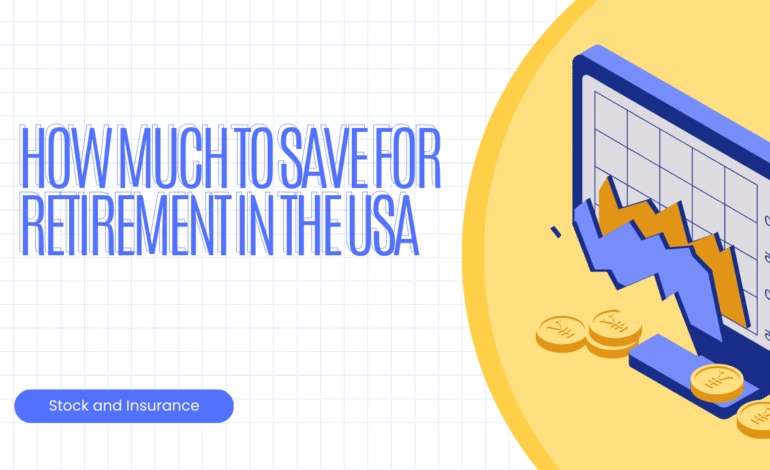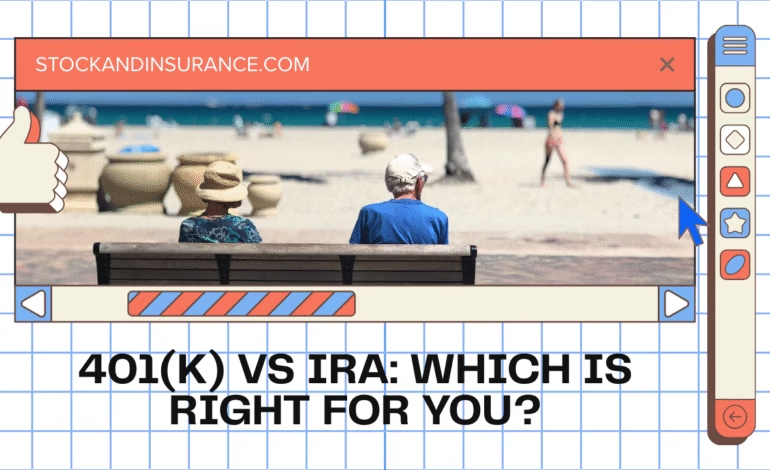
Retirement savings UK and RRSP Canada may sound like heavy financial terms, but planning for them is often more like attending a family wedding. Everyone talks about it, few actually prepare for it, and there is always that one uncle who insists you do not need to worry because the government will take care of you. Spoiler alert: relying only on that plan might leave you sipping instant coffee in retirement instead of enjoying that dream beach cocktail.
Now, before you scroll away thinking this is just another boring finance article, hear me out. Retirement savings do not have to be dry, complicated spreadsheets and tax codes. Think of them as a backstage pass to your future lifestyle whether that means golfing in Spain, gardening in Canada, or simply binge-watching Netflix guilt free because you are financially secure.
Both Canada and the UK have their own unique systems for helping you save. One gives you tax breaks today through the Canadian RRSP, while the other ensures your employer chips in through the UK pension system. It is a little like choosing between a free dessert now or a free meal later.
So grab your cup of tea, or maybe a Tim Hortons if you are Canadian, and let us explore these two retirement systems in a way that is clear, useful, and maybe even a little fun.
Whether you live in the UK, Canada, or any other developed country, retirement savings are not just about putting money aside. They are about ensuring financial freedom, healthcare security, and a lifestyle of choice rather than compromise.
In this blog, we will explore two of the world’s most structured retirement frameworks: retirement savings UK and RRSP Canada. You will learn not just the rrsp meaning Canada but also how it compares to the best retirement savings Canada options.
Let’s start with the Canadian retirement system before comparing it with the UK.
Understanding RRSP Canada
If you are new to investing or just starting your career, you have probably heard the term RRSP. But what is the rrsp meaning Canada?
RRSP stands for Registered Retirement Savings Plan. It is a government-supported, tax-advantaged account that allows Canadians to save for retirement. The key benefits are:
- Contributions are tax-deductible, lowering your taxable income.
- Growth inside the RRSP (dividends, interest, capital gains) is tax-deferred until withdrawal.
- You can contribute up to 18 percent of your previous year’s income, capped at around CAD $31,560 for 2026.
Why RRSP Canada is Considered the Best Retirement Savings Canada
- Tax Deduction Advantage
Suppose you earn CAD $80,000 annually and contribute $10,000 to an RRSP. This reduces your taxable income to $70,000, saving you thousands in taxes today. - Compound Growth Power
Because investments inside RRSP are tax-deferred, compounding works faster. A 30-year-old who invests CAD $6,000 annually at 7 percent could accumulate nearly CAD $600,000 by age 60. - Flexibility for First-Time Home Buyers and Education
RRSP allows withdrawals under the Home Buyers Plan (HBP) and Lifelong Learning Plan (LLP). This makes it more flexible compared to traditional pension accounts.
RRSP vs TFSA: What Canadians Should Know
While RRSP is often considered the best retirement savings Canada choice, it is important to compare it with the Tax-Free Savings Account (TFSA).
- RRSP: Contributions are tax-deductible but withdrawals are taxable.
- TFSA: Contributions are not tax-deductible, but withdrawals are tax-free.
A smart strategy is to use both. RRSP is excellent during high-income years, while TFSA is better if you are starting small or expect higher income taxes in retirement.
Real-Life Example: RRSP in Action
Imagine Emily, a 32-year-old engineer in Toronto. She contributes CAD $500 per month to her RRSP. With a 7 percent return, she will have more than CAD $500,000 by 60. Add in her employer pension and CPP (Canada Pension Plan), and she is well on track for a comfortable retirement.
Retirement Savings Beyond RRSP Canada
While RRSP is the backbone, other plans also matter:
- CPP (Canada Pension Plan): Provides monthly income in retirement, based on your contributions.
- OAS (Old Age Security): Government-provided benefit at age 65.
- Workplace Pensions: Defined contribution or defined benefit plans.
Together with RRSP, these create a strong multi-layered retirement safety net.
In Canada, the Year’s Maximum Pensionable Earnings (YMPE) for 2025 has been set at CAD $71,300, up from $68,500 in 2024. The new Year’s Additional Maximum Pensionable Earnings (YAMPE) is CAD $81,200, which extends CPP contributions to higher income brackets under the CPP2 program. Employers and employees will each contribute 5.95% of covered earnings, while self-employed individuals contribute 11.90%. For more details, see the official Canada Revenue Agency announcement.
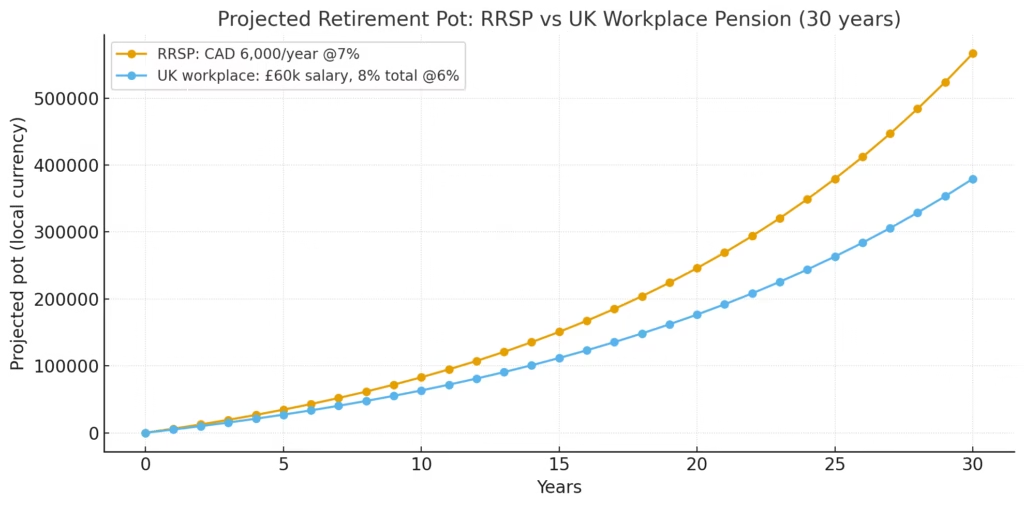
Retirement Savings UK – Building a Pension for the Future
Unlike Canada’s RRSP system, retirement savings UK revolve primarily around workplace pensions and state pensions. Every worker in the UK contributes to National Insurance, which funds the state pension. On top of that, most employers are now legally required to offer a workplace pension under auto-enrolment rules.
This makes retirement savings UK a combination of:
- State Pension – Government-provided income after a minimum number of qualifying years.
- Workplace Pension – Contributions from both employee and employer, invested for growth.
- Personal Pensions – Voluntary plans for additional savings, often used by self-employed workers.
UK State Pension: The Foundation
To qualify for the full state pension in 2026, you must have 35 qualifying years of National Insurance contributions. The amount is about £11,500 annually, adjusted for inflation.
While it provides a steady base, most financial advisors agree it is not enough for a comfortable retirement. That is why retirement savings UK heavily emphasizes workplace and personal pensions.
Workplace Pensions and Auto-Enrolment
Since 2012, employers in the UK must automatically enroll eligible workers into a pension scheme. Contributions are split:
- Employees contribute at least 5 percent of qualifying earnings.
- Employers contribute at least 3 percent.
These funds are typically invested into diversified portfolios, similar to Canadian mutual funds. Over time, contributions plus investment returns build a significant retirement pot.
In the UK, employers must automatically enrol eligible workers into pension schemes and contribute alongside employee contributions. More details are available on the UK government’s official Workplace Pensions guidance.
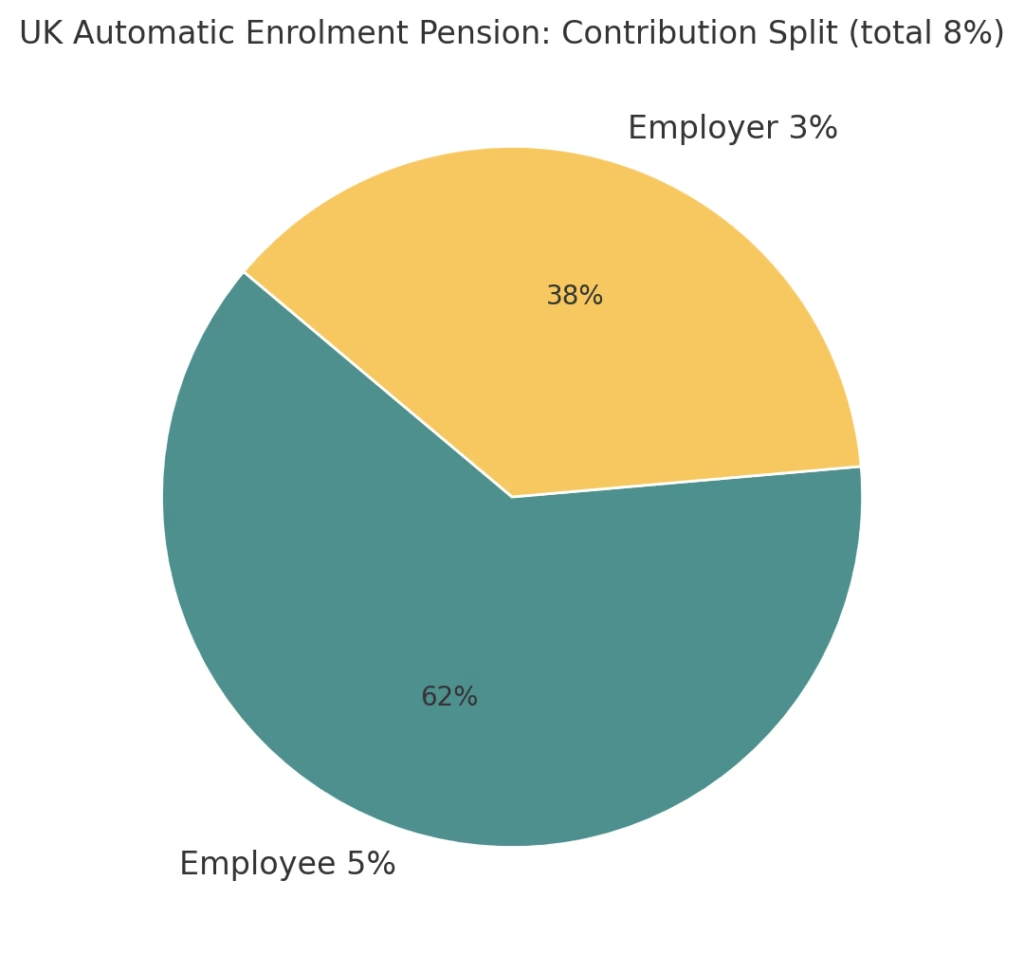
Personal Pensions and SIPPs (Self-Invested Personal Pensions)
For freelancers, entrepreneurs, or anyone who wants more control, the UK offers SIPPs. These accounts allow investors to choose from a wider range of assets like stocks, ETFs, and funds.
This flexibility makes SIPPs attractive, especially for higher earners who want to maximize retirement savings UK while also tailoring investments to their risk appetite.
Real-Life Example: UK Retirement Planning
Consider James, a 40-year-old marketing professional in London earning £60,000 annually. He contributes 5 percent of his income (£3,000) to his workplace pension, matched by his employer with 3 percent (£1,800). With investment growth averaging 6 percent, his pension pot could grow to nearly £700,000 by retirement, excluding state pension benefits.
Canada vs UK: A Quick Comparison
| Feature | RRSP Canada | Retirement Savings UK |
|---|---|---|
| Tax Benefit | Contributions tax-deductible | Tax relief on pension contributions |
| Withdrawal Rules | Taxable upon withdrawal | Flexible access at age 55+ with tax |
| Government Pension | CPP + OAS | State Pension |
| Employer Contributions | Optional, varies | Mandatory auto-enrolment |
| Best For | High earners and tax efficiency | Employees with stable employers |
This table shows how retirement savings in UK and Canada are structured differently, but both aim at the same goal: providing steady income during retirement.
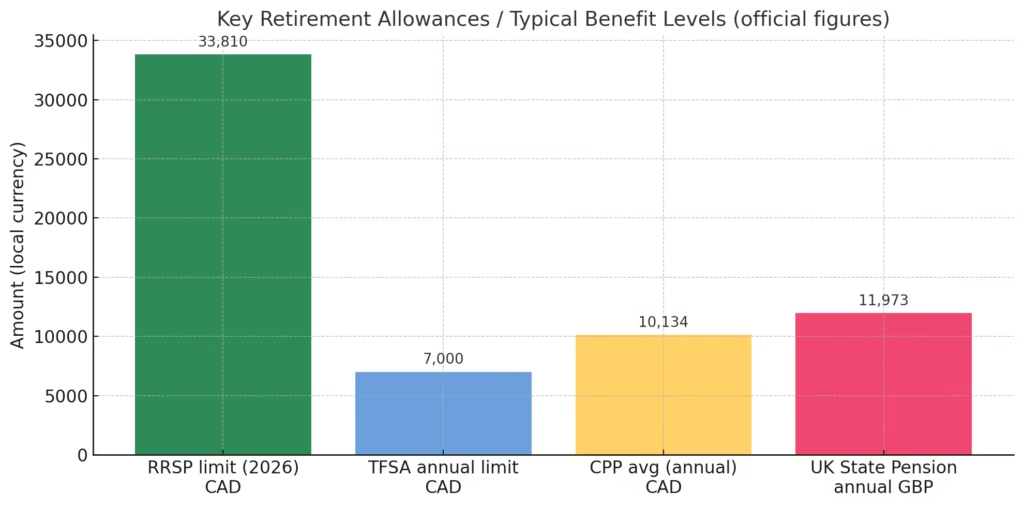
Question for You
If you had to choose today, would you prefer tax deductions upfront like in RRSP Canada or steady employer contributions like in the UK pension system? Drop your thoughts in the comments, as your strategy might depend on your income and career path.
Retirement Savings Canada vs UK – Final Insights
Comparing RRSP Canada and Retirement Savings UK
Both Canada and the UK offer structured retirement savings programs, but they differ in tax treatment, flexibility, and long-term benefits.
- Tax Advantages
- RRSP Canada allows contributions to be deducted from taxable income, giving immediate tax relief. Withdrawals in retirement are taxed, often at a lower rate.
- Retirement savings UK provide tax relief upfront on contributions, but withdrawals after age 55 are partly taxable, with 25 percent tax-free.
- Employer Support
- In Canada, employer contributions to RRSPs are optional. Many companies instead offer group RRSPs or pension plans, but it varies.
- In the UK, employer contributions are mandatory through auto-enrolment, ensuring workers get matched support.
- Withdrawal Flexibility
- RRSP withdrawals are restricted, though programs like the Home Buyers’ Plan allow penalty-free early use for buying a first home.
- UK pensions can be accessed at age 55, with more flexibility in taking lump sums, drawdowns, or annuities.
Best Retirement Savings Canada: Beyond RRSP
While RRSP Canada is the most recognized, Canadians also use:
- TFSA (Tax-Free Savings Account) – Growth and withdrawals are tax-free, making it a great complement to RRSP.
- Employer Pension Plans – Defined benefit or defined contribution plans add another layer of security.
- Non-registered Investments – For high-net-worth individuals, these provide flexibility beyond contribution limits.
Retirement Savings UK: Beyond Auto-Enrolment
In the UK, smart savers expand beyond the state and workplace pensions by using:
- SIPPs – Giving control over asset allocation and investment strategies.
- ISA (Individual Savings Accounts) – Tax-free savings and investment accounts that pair well with pensions.
- Lifetime ISA (LISA) – Specifically designed for younger savers under 40, offering government bonuses for retirement.
Many Canadians and UK residents often wonder whether retirement savings strategies differ for wealthy individuals compared to average savers. Interestingly, high-net-worth individuals tend to diversify their retirement portfolios more aggressively, balancing RRSPs with global funds, tax-efficient bonds, and alternative assets. If you want to see how they are structuring their investments in 2026, check out our detailed guide on High-Net-Worth Individuals Diversify Their Portfolios in 2026.
Expat Considerations: Moving Between Canada and the UK
For professionals working across both countries, retirement planning requires extra care:
- Contributions to RRSP Canada generally stop once you are no longer a Canadian tax resident.
- UK pensions may still grow even if you leave the country, depending on the plan rules.
- Expatriates should review tax treaties between Canada and the UK to avoid double taxation on withdrawals.
- Consolidating pensions or using international pension transfer schemes can make long-term planning simpler.
Action Plan: How to Maximize Your Retirement Savings
- Start Early – The earlier you invest, the more compounding works in your favor.
- Diversify – Use a mix of government programs (RRSP, TFSA, pensions) and personal investments.
- Know Your Taxes – Both Canada and the UK reward savers with tax relief, but the timing of when you pay tax differs.
- Leverage Employer Contributions – Never leave free money on the table in workplace pension schemes. The Gov.uk workplace pension rules ensure employers contribute at least 3% to employee pensions.
- Seek Professional Guidance – Cross-border retirement planning often requires expert advice to maximize benefits.
Real-Life Example: Comparing Two Savers
- Emily in Toronto contributes $8,000 annually into her RRSP and $5,000 into her TFSA. By 65, she projects a retirement portfolio of $1.1 million, enjoying tax-free withdrawals from her TFSA and taxable income from RRSP at a lower bracket.
- Oliver in Manchester contributes 8 percent of his salary (£5,000 annually) into his workplace pension, matched with 3 percent from his employer. Combined with his state pension, he expects an annual retirement income of about £45,000.
Both demonstrate how structured retirement savings in Canada and the UK can lead to a comfortable lifestyle, though through slightly different paths.
Final Thoughts
Whether you choose RRSP Canada, TFSA, or retirement savings UK through workplace pensions and SIPPs, the core principle remains the same: consistent saving, smart investing, and leveraging tax benefits are key to long-term security.
If you are just starting, the question is not where but how soon. The earlier you begin, the easier your retirement journey will be.
A Quick Question for You
How much do you think you will realistically need per year to retire comfortably in your country? Share your number in the comments and let us see how goals differ between Canada and the UK.

